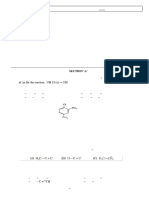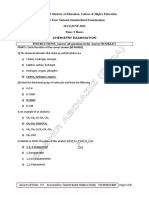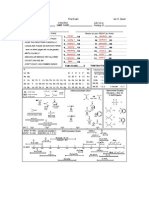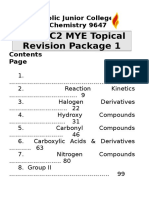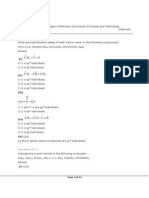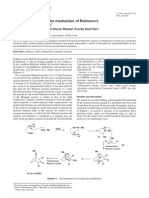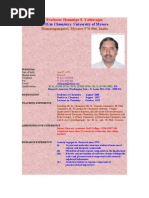Chemistry 30A UCLA Fall 2009 Midterm Exam II KEY: On My Honor, I Have Neither Given Nor Received Any Aid On This Exam
Chemistry 30A UCLA Fall 2009 Midterm Exam II KEY: On My Honor, I Have Neither Given Nor Received Any Aid On This Exam
Uploaded by
ViceregalCopyright:
Available Formats
Chemistry 30A UCLA Fall 2009 Midterm Exam II KEY: On My Honor, I Have Neither Given Nor Received Any Aid On This Exam
Chemistry 30A UCLA Fall 2009 Midterm Exam II KEY: On My Honor, I Have Neither Given Nor Received Any Aid On This Exam
Uploaded by
ViceregalOriginal Description:
Original Title
Copyright
Available Formats
Share this document
Did you find this document useful?
Is this content inappropriate?
Copyright:
Available Formats
Chemistry 30A UCLA Fall 2009 Midterm Exam II KEY: On My Honor, I Have Neither Given Nor Received Any Aid On This Exam
Chemistry 30A UCLA Fall 2009 Midterm Exam II KEY: On My Honor, I Have Neither Given Nor Received Any Aid On This Exam
Uploaded by
ViceregalCopyright:
Available Formats
Chemistry 30A
UCLA Fall 2009
Midterm Exam II KEY
On my honor, I have neither given nor received any aid on this exam
Signature:
KEY
Name:
KEY
UCLA Student I. D. Number:
Question
Points
--------------------------------------1 (28)
--------------------------------------2 (24)
--------------------------------------3 (15)
--------------------------------------4 (18)
--------------------------------------5 (20)
--------------------------------------6 Extra Credit (5)
--------------------------------------Total
Chemistry 30A, Fall 2009
Page 1
Name: KEY
THEORY
1.
A. (4) Calculate the Double Bond Equivalents (DBE) (Degree of Unsaturation) for C12H18BrClN2O2.
DBE = #C (#H + #X)/2 + (#N)/2 +1 = 12 (18+2)/2 + 2/2 + 1 = 4
B. (4) Circle the isoprene units in abietic acid.
HOOC
HOOC
C. (4) Define stereospecific reaction using words and an example.
A reaction wherein the stereochemistry of the product is dependent on the
stereochemistry of the starting material. For example, syn dihydroxylation of cis or
trans alkenes. For example, syn hydroboration of cis or trans alkenes.
D. (4) Draw the structure of the tertiary butyl cation clearly showing its geometry and label the
hybridization at the cationic carbon.
H3C
H3C
CH3
sp2 Hybridized Carbon
Planar Structure
E. (4) What two factors contribute to the stability of tertiary butyl cation verses methyl cation?
1) Inductive release of electron density by the alkyl groups to the cation center.
2) Hyperconjugation which is overlap of an adjacent C-H sigma orbital with the
F. (4) What physical property dominates the difference in boiling points between two alkynes.
Molecular Weight
G. (4) Define a Lewis Acid.
Electron pair acceptor such as H+ or AlCl3
Chemistry 30A, Fall 2009
Page 2
Name: KEY
THEORY and NOMENCLATURE
2. (24)
A. (4) Name the following compound using IUPAC rules including absolute stereochemistry.
Br
trans,cis-(7S)-7-bromo-2,5-nonadiene
B. (4) Name the following compound using IUPAC rules including absolute stereochemistry.
F
Br
Z-(7S)-4-bromo-3-chloro-7-fluoro-3-octene
Cl
C. (4) Draw the structure of (5S)-5-bromo-4,4-dimethyl-1-nonen-6-yne.
Br
D. (4) Draw the structure of bicyclo[6.3.0]-4-undecyne.
E. (4) Name the following compound using COMMON NAMES.
(R)-1-allyl-3-methylene-1-vinyl-cyclopentane
F. (4) Calculate the Enthalpy of Reaction (Horxn) for the following reaction using the Bond
Dissociation Enthalpies (Ho) given.
Ho Data (kcal/mol):
H-H 104
H-C 101
H-I
71
I-I
36
C-I
57
C=C 90 ( only)
HI
Horxn = Sum (bonds broken) - Sum (bonds formed)
= (71 + 90) (101 + 57)
= +3 kcal/mol
Chemistry 30A, Fall 2009
Page 3
Name: KEY
MECHANISMS
3.
A. (8) Propose a detailed mechanism to explain the following transformation.
H2O H2SO4
OH
H3O+
H2O
H2O
OH
O
H
B. (7) Draw the Reaction Coordinate Diagram for the mechanism proposed in part 3A.
LABEL structures associated with each energy level.
LABEL the Free Energy of Reaction (Gorxn).
For the rate determining step LABEL the transition state and the Activation Energy (EA).
Transition
State
2o
Cation
E
Ea
3o
Cation
ROH2
Cation
Alkene
!Gorxn
Alcohol
Reaction Coordinate
Chemistry 30A, Fall 2009
Page 4
Name: KEY
REACTIONS and SYNTHESES
4. (18) Suggest reagents, starting materials or products for the following transformations.
Pay attention to Regiochemistry and Stereochemistry!
A.
OH
OH
1) OsO4
2) NaHSO3 H2O
B.
OH
Br
Br2 H2O
C.
O
1) O3 CH2Cl2
2) Me2S
O
D.
H2 Lindlar's catalyst
OR 1) Sia2BH THF 2) AcOH
OR Nao NH3
E.
H
1) Sia2BH THF
O
2) H2O2 NaOH H2O
F.
Br
1 eq Br2
Br
Chemistry 30A, Fall 2009
Page 5
Name: KEY
REACTIONS and SYNTHESIS
5. (20) Suggest reagents to accomplish the following transformations or suggest reaction products.
Pay attention to Regiochemistry and Stereochemistry!
A.
1) Nao
Br
NH3
2) 1 eq Br2
Br
B.
Me
1) BH3 THF
2) H2O2 NaOH H2O
OH
C.
1) NaNH2
Pr-I
Cl
2) H2 Lindlar's catalyst
3) Cl2 Ethyl alcohol
D.
HBr
Br
E.
1) Br2
2) 3 equiv NaNH2
3) NaNH2
Br
AND
Cl
Chemistry 30A, Fall 2009
Page 6
Name: KEY
EXTRA CREDIT
6. (5) Answer Only One Question Using Both Words and Drawings.
Explain how ozone in the stratosphere protects us.
OR
Explain how the following molecule (rhodopsin) allows us to see.
Opsin
A. Ozone in the stratosphere can adsorb a high energy photon of UVC light to give
an excited state molecule which falls apart to oxygen and an oxygen atom.
Recombination of these reforms ozone and releases heat. So there is a net
conversion of light to heat. Ultraviolet C light is responsible for damage to DNA
which results in skin cancer.
O
h!
O
O
O
O.
+"
B. Rhodopsin can adsorb a photon of light to give an excited state molecule that then
decays by isomerizing to the all trans polyene. This trans molecule interacts with
other molecules due to its different shape and this creates a chemical signal that is
relayed down the neural path to the brain.
*
h!
N
Opsin
Opsin
Opsin
Biological
Signaling
You might also like
- Chemistry Past 10 Year Papers 2002-2013Document106 pagesChemistry Past 10 Year Papers 2002-2013siddharth199650% (2)
- Chapter 5: Structure and Preparation of Alkenes - Elimination ReactionsDocument13 pagesChapter 5: Structure and Preparation of Alkenes - Elimination ReactionsRahma AshrafNo ratings yet
- Organic Chemistry Practice MidtermDocument7 pagesOrganic Chemistry Practice MidtermAmy HanNo ratings yet
- Organ Part I A PaperDocument10 pagesOrgan Part I A PaperMinh TieuNo ratings yet
- Review Questions: Medicinal Chemistry 300550Document49 pagesReview Questions: Medicinal Chemistry 300550vanyarufusNo ratings yet
- Worksheet For Organic SectionDocument17 pagesWorksheet For Organic SectionPramudith Liyanage100% (2)
- A CIDITYDocument17 pagesA CIDITYApex InstituteNo ratings yet
- Organic Basic 25 Marks 6-12-2023Document2 pagesOrganic Basic 25 Marks 6-12-2023nazneen obaidNo ratings yet
- Sample Paper Gr11Document3 pagesSample Paper Gr11Enoca AJ100% (1)
- Organic Chemistry Some Basic Principles and Techniques Worksheet GRADE 11.Docx (1)Document16 pagesOrganic Chemistry Some Basic Principles and Techniques Worksheet GRADE 11.Docx (1)vanshgarcha123No ratings yet
- Anic Chemistry AK 2018-19Document22 pagesAnic Chemistry AK 2018-19XXXNo ratings yet
- OCHEM Practice FinalDocument24 pagesOCHEM Practice FinalNoleNo ratings yet
- Acidicity Basicity & H - Bonding Tautomerism (Q.B.) 12thDocument16 pagesAcidicity Basicity & H - Bonding Tautomerism (Q.B.) 12thAritra Lahiri100% (1)
- Mtp-t2-Chemistry-11 2324Document4 pagesMtp-t2-Chemistry-11 2324Neeta RaniNo ratings yet
- SCGS F.7 AL Chemistry Assignment 2 - HALOALKANESDocument1 pageSCGS F.7 AL Chemistry Assignment 2 - HALOALKANESsachinkurhekarNo ratings yet
- IUPAC NOMENCLATURE Work Sheet For IIT RevisionDocument11 pagesIUPAC NOMENCLATURE Work Sheet For IIT Revisionhotah61811No ratings yet
- 549 Practice Paper 1 of IUPAC Nomenclature @GenetryDocument12 pages549 Practice Paper 1 of IUPAC Nomenclature @Genetryayush.k2009rNo ratings yet
- chemistry q.p XI PTII2019Document3 pageschemistry q.p XI PTII2019shriyamgoyalNo ratings yet
- Paper 2 DP2 HL T2 2019-MarkschemeDocument16 pagesPaper 2 DP2 HL T2 2019-MarkschemeconcessiozacharyNo ratings yet
- Organic Chem (With Solution) 2Document75 pagesOrganic Chem (With Solution) 2vlNo ratings yet
- Chemistry Oo Kashqeysan Imtixaanka Dowlada 2022Document6 pagesChemistry Oo Kashqeysan Imtixaanka Dowlada 2022cazmi AndirahmanNo ratings yet
- Chapter 6 Properties of HaloalkaneDocument5 pagesChapter 6 Properties of HaloalkaneRen Liew Jia QingNo ratings yet
- University of LimpopoDocument13 pagesUniversity of Limpopoamanda rampediNo ratings yet
- XI Mid Term QPDocument3 pagesXI Mid Term QPtechnical SiteNo ratings yet
- 429 SampleDocument40 pages429 Samplejerrica thomasNo ratings yet
- Carbon and Its CompoundsDocument1 pageCarbon and Its CompoundsPraksh Bhayana30No ratings yet
- OCHEM Practice FinalsDocument13 pagesOCHEM Practice FinalsNoleNo ratings yet
- 11th chemistry test paper redox and gocDocument6 pages11th chemistry test paper redox and gocSandeep YadavNo ratings yet
- 12che04 QPDocument8 pages12che04 QPadityaNo ratings yet
- 11th Chemistry Model PaperDocument13 pages11th Chemistry Model Papersasi.curieNo ratings yet
- Organic Exam Answer.Document11 pagesOrganic Exam Answer.S JNo ratings yet
- Tutorial 5Document4 pagesTutorial 5Eqieyn JerrNo ratings yet
- Organic C CCCC CCCCDocument88 pagesOrganic C CCCC CCCCKugan KishurNo ratings yet
- NOMENCLATDocument6 pagesNOMENCLATprasanthkumar200512No ratings yet
- CH 4 StudyDocument11 pagesCH 4 StudyLiz Hans0% (1)
- Alkyl Halides INTRO WS - SV - Spring 2023Document2 pagesAlkyl Halides INTRO WS - SV - Spring 2023Shonte ScottNo ratings yet
- Post Mid Term9th PaperDocument7 pagesPost Mid Term9th PaperJyoti SumanNo ratings yet
- IUPAC Practice sheetDocument19 pagesIUPAC Practice sheetnayceebamania0106No ratings yet
- Sample paper 8Document6 pagesSample paper 8seetaseeta241No ratings yet
- IUPAC AND ISOMERISMDocument25 pagesIUPAC AND ISOMERISMappu78No ratings yet
- Chapter 12 Organic Chemistry Some Basic Principles and TechniquesDocument34 pagesChapter 12 Organic Chemistry Some Basic Principles and TechniquesAnonymous 8VJhV1eI2yNo ratings yet
- 09-Final With SolutionsDocument27 pages09-Final With SolutionsDanielle Wood100% (2)
- WS Class 11 Org ChemDocument4 pagesWS Class 11 Org ChemJavedNo ratings yet
- Maharashtra SET Exam Paper II Chemical Science Question Paper November 2011Document15 pagesMaharashtra SET Exam Paper II Chemical Science Question Paper November 2011pednekarprakashNo ratings yet
- Chapter 03Document40 pagesChapter 03Yelo AlmasenNo ratings yet
- Chapter 6Document47 pagesChapter 6Lauren Zimmerman100% (1)
- Class - 11, Chemistry (Set B), Unit Test II (24-25)Document3 pagesClass - 11, Chemistry (Set B), Unit Test II (24-25)itzunknown999999No ratings yet
- Org Chem 3Document37 pagesOrg Chem 3tyron9520100% (1)
- Final Xi B CheDocument4 pagesFinal Xi B CheASM CHENo ratings yet
- Exam Answers Quiz KeysDocument24 pagesExam Answers Quiz Keysseanra23No ratings yet
- Chem 0000Document5 pagesChem 0000chikondikosamu24No ratings yet
- P. Joy: Class Test - 2 (Inorganic)Document1 pageP. Joy: Class Test - 2 (Inorganic)SubhojyotiDasNo ratings yet
- Organic Chemistry Questions 3Document12 pagesOrganic Chemistry Questions 3Ram KrishnaNo ratings yet
- SET- (12) question paperDocument15 pagesSET- (12) question paperkiransujan587No ratings yet
- ChemistryDocument8 pagesChemistrySuyash SuyashNo ratings yet
- Read The Following Instructions Very Carefully Before You ProceedDocument22 pagesRead The Following Instructions Very Carefully Before You ProceedSwapan Kumar MajumdarNo ratings yet
- Graphene Oxide: Fundamentals and ApplicationsFrom EverandGraphene Oxide: Fundamentals and ApplicationsAyrat M. DimievNo ratings yet
- Unusual Structures and Physical Properties in Organometallic ChemistryFrom EverandUnusual Structures and Physical Properties in Organometallic ChemistryNo ratings yet
- Experimental and Theoretical Approaches to Actinide ChemistryFrom EverandExperimental and Theoretical Approaches to Actinide ChemistryJohn K. GibsonNo ratings yet
- Physics 4AL - Complete Lab Report 3Document11 pagesPhysics 4AL - Complete Lab Report 3ViceregalNo ratings yet
- Chem153A Bates Final Key F05Document11 pagesChem153A Bates Final Key F05ViceregalNo ratings yet
- Chem14D Exam1 2010-KeyDocument4 pagesChem14D Exam1 2010-KeyViceregalNo ratings yet
- Mastering Physics - CDocument30 pagesMastering Physics - CViceregal80% (5)
- Mastering Physics - CDocument30 pagesMastering Physics - CViceregal80% (5)
- CHAPTER 2 - The ConstitutionDocument6 pagesCHAPTER 2 - The Constitutionscott100% (1)
- Class 12 - Aldehydes, Ketones and Carboxylic Acids - 24577953Document4 pagesClass 12 - Aldehydes, Ketones and Carboxylic Acids - 24577953Aryan KhandkaNo ratings yet
- SP Carey - Parte BDocument260 pagesSP Carey - Parte BLeanne SilvaNo ratings yet
- https___app.oswaalbooks.com_download_sample-qp_subsolution_912Self Assessment Paper-8Document2 pageshttps___app.oswaalbooks.com_download_sample-qp_subsolution_912Self Assessment Paper-8Rishit RoyNo ratings yet
- IsomerismDocument140 pagesIsomerismVinushree SanthoshkumarNo ratings yet
- Boron HydrideDocument10 pagesBoron HydrideZul AndriNo ratings yet
- CH 44 Organic Reactions - Supp Ex 1 (Updated)Document4 pagesCH 44 Organic Reactions - Supp Ex 1 (Updated)伊貝P-No ratings yet
- Dimethyl SulfideDocument20 pagesDimethyl SulfideRichard SapienzaNo ratings yet
- Fruto NileDocument9 pagesFruto Niles224wcjzs7No ratings yet
- Lecture 9 - Alcohols and Alkyl HalidesDocument43 pagesLecture 9 - Alcohols and Alkyl Halidesapi-19824406No ratings yet
- Alkenes and Alkynes I: Properties and Synthesis. Elimination Reactions of Alkyl HalidesDocument84 pagesAlkenes and Alkynes I: Properties and Synthesis. Elimination Reactions of Alkyl Halidesluiji yahabaNo ratings yet
- Welcome To Chem 206: Fall Term, 2005, David A. EvansDocument22 pagesWelcome To Chem 206: Fall Term, 2005, David A. EvanseraborNo ratings yet
- 2016-Board Paper SolutionDocument12 pages2016-Board Paper SolutionSaugata HalderNo ratings yet
- Org PhotochemDocument20 pagesOrg PhotochemAnil KumarNo ratings yet
- JEE Main 2024 (January 27 Shift 1) Chemistry Question Paper With Solutions (PDF)Document5 pagesJEE Main 2024 (January 27 Shift 1) Chemistry Question Paper With Solutions (PDF)iamkhare123No ratings yet
- (B) Curriculum For B.Sc. Degree in Industrial Chemistry 100 Level Harmattan Semester Course Code Course Title Pre-Requisite Units StatusDocument15 pages(B) Curriculum For B.Sc. Degree in Industrial Chemistry 100 Level Harmattan Semester Course Code Course Title Pre-Requisite Units StatusAbdulganeey Horlarmilekan MuheezNo ratings yet
- Chiroptical PropertiesDocument55 pagesChiroptical PropertiesMd Ibrahim100% (1)
- Quaternary Ammonium CompoundsDocument5 pagesQuaternary Ammonium CompoundsRana Sab0% (1)
- Naming Alkanes Ws 1 and Ws 2Document4 pagesNaming Alkanes Ws 1 and Ws 2Kristoff Avila50% (2)
- Dr. Talib Hussain, Phd. Lecturer, Ips, Uvas, LahoreDocument28 pagesDr. Talib Hussain, Phd. Lecturer, Ips, Uvas, LahoreUsama NaushahiNo ratings yet
- Theoretical Study On The Mechanism of Robinson's Synthesis of TropinoneDocument4 pagesTheoretical Study On The Mechanism of Robinson's Synthesis of TropinoneDr-Muhammad Imran TousifNo ratings yet
- Structure of EthyleneDocument1 pageStructure of EthyleneCarry OnNo ratings yet
- CH 16: Chemistry of Benzene: Renee Y. Becker CHM 2211 Valencia Community CollegeDocument77 pagesCH 16: Chemistry of Benzene: Renee Y. Becker CHM 2211 Valencia Community CollegeZhu RichNo ratings yet
- RSNaDocument20 pagesRSNaSagung DyahNo ratings yet
- Working With Hazardous Chemicals: A Publication of Reliable Methods For The Preparation of Organic CompoundsDocument4 pagesWorking With Hazardous Chemicals: A Publication of Reliable Methods For The Preparation of Organic CompoundsEdgardo Ed RamirezNo ratings yet
- Resume of Professor Yathi - Convert To PDFDocument43 pagesResume of Professor Yathi - Convert To PDFyathirajan8886No ratings yet
- Biochem 2aDocument4 pagesBiochem 2aJessica Lorenz PablicoNo ratings yet
- Practical BiochemistryDocument108 pagesPractical BiochemistryAditiNo ratings yet
- Synthetic Reagents and Applications: 1.aluminium Isopropoxide 2.N-Bromosuccinimide 3.diazomethaneDocument19 pagesSynthetic Reagents and Applications: 1.aluminium Isopropoxide 2.N-Bromosuccinimide 3.diazomethaneHimanshu PanchalNo ratings yet
- TG TableDocument2 pagesTG Tableantimony arNo ratings yet
- Haloalkanes and Haloarenes Question Bank 1690183665Document26 pagesHaloalkanes and Haloarenes Question Bank 1690183665Pratibaa LNo ratings yet













